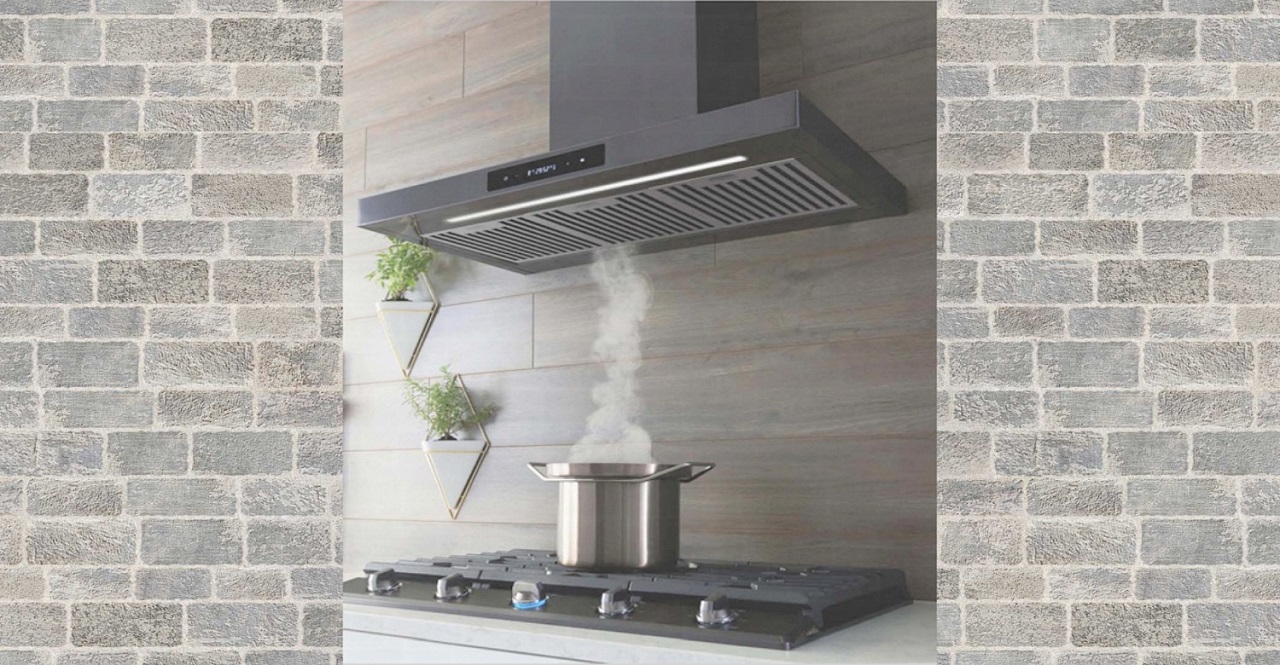A modern-day kitchen wouldn’t be complete without installing a hood. In this article, I will be walking you through how does a kitchen hood work and how to get the best out of it.
Generally, hoods are an essential device that keeps your kitchen free from smoke and smell while you are cooking your favorite dishes.
So, join me in discovering more about kitchen hoods.
What is a Kitchen Hood
A kitchen hood is also known by the names below:
- a “Cooker Hood”
- a “Range Hood”
- or is simply called a “Hood”
They are all the same and function the same. That is to extract out fumes generated during cooking that could help to keep your kitchen tidy.
It is important to note also that there are kitchen hood designs that need to be vented out using the supplied flexible duct that comes along as an accessory. This is common for the wall-mount types of hoods as well as the normal island hoods that come with chimneys.
On the other hand, there are ductless kitchen hoods that employ recirculation. This design is normally utilized in standard hoods, telescopic hoods, and some special types of island hoods.
Note: "Recirculation" means that the fumes sucked in by the cooker hood will pass through a carbon filter then the air is released also inside the kitchen through the vents of the hood. This is the reason why this kind of range hood is called recirculation type and is normally ductless.
Types of Kitchen Hoods
As I have covered in my previous article about What is Major Domestic Appliances, there are many kinds of kitchen hoods.
I’ll try to summarize it here again for the sake of our readers. And at the same time, I will add some more that were not mentioned before.
So to start, here are the different types of kitchen hoods.
1. Standard Hood
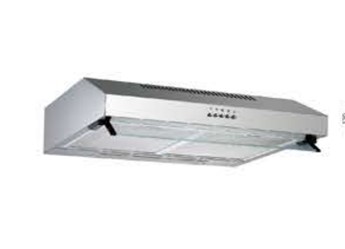
- Standard hoods are slim types of cooker hoods and ideal for small kitchens (e.g. studio type condo units)
- Depending on the manufacturers, these hoods can be accessorized with flexible exhaust pipe (duct)
- Common sizes – 60cm, 90cm
- Basic design has three speeds
- Normally installed under a cabinet
- Recirculation type (ductless) is also available for this kind of hood and usually comes with carbon filters
2. Telescopic Hood
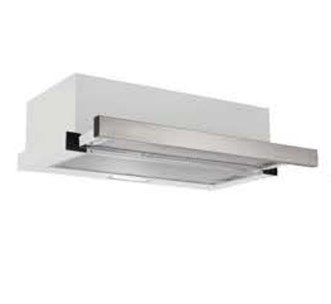
- Telescopic hoods are also ideal for small kitchens (e.g. studio type condo units)
- The front panel of telescopic hood can be extended as per design
- Depending on the manufacturers, these hoods can also be accessorized with flexible exhaust pipe (duct)
- Common sizes – 60cm, 90cm
- Basic design has two speeds using a rocker switch. However, three-speed designs are also available and speed controls are on the front panel
- Normally installed under a cabinet
- Recirculation type (ductless) is also available for this kind of hood and usually comes with carbon filters
3. Wall-mount Hood

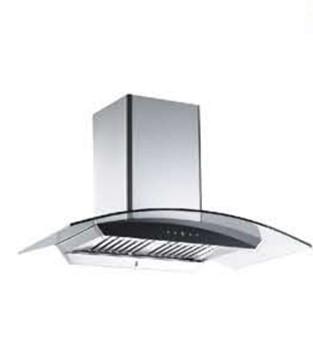
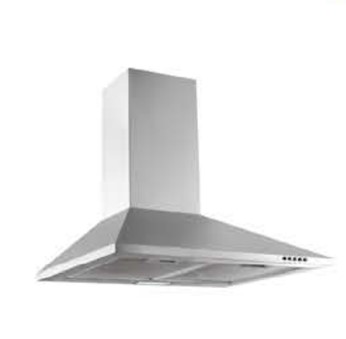
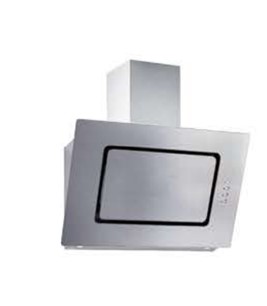
- Wall-mount hoods come in a variety of designs.
- the most popular is the “T-shape”
- there’s also the “curve glass”
- another design is the “pyramid shape”
- now gaining attention is the “slant type” (which mostly comes with glass panels)
- and many other odd shapes or forms
- Common sizes – 60cm, 90cm
- Basic design has three speeds with either push-button or touch controls
- Main material is aluminum and some designs have glass control panels
- Advance designs have incorporated hand gestures to control function
- Newer designs also have the self-cleaning functions (either by steam or by the heating element to clean automatically oil residue)
- As the name suggests this kind of hood is installed or mounted on the wall
- Usually comes with flexible exhaust pipe (duct) to be vented outside
4. Island Hood
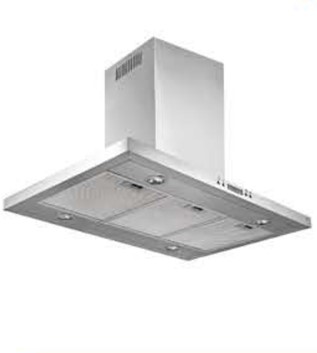
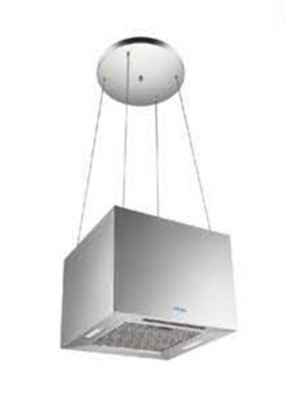
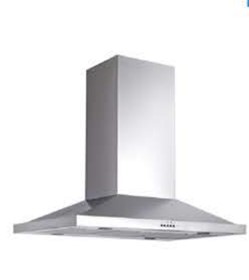
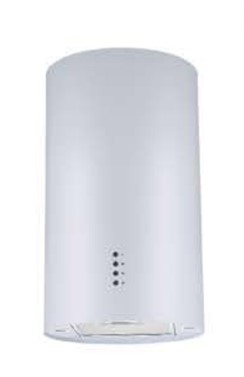
- Island hoods also come in a variety of designs.
- the most popular is the “T-shape”
- there’s also the “curve glass”
- another design is the “pyramid shape”
- decorative types are also available and in many shapes and forms
- cylindrical type of island hoods are becoming an option
- and there are more different shapes and designs
- Common sizes (for T-shape, curve glass, pyramid shape) – 60cm, 90cm
- For decorative type, smaller sizes are approximately 40 x 40 cm. However, some designs have a width of 60cm and 90cm respectively that are available according to your need
- Basic designs have three speeds with touch controls and decorative models may include a remote control
- Installation of this kind of hood will depend on the location and the island kitchen’s overall design.
- A common kitchen hood with a chimney usually comes with a flexible exhaust pipe (duct), thus, it’s the end-user’s option how to utilize the supplied accessory
- The decorative type will normally employ a recirculation design as there’s no way you can connect a pipe to vent outside
5. Ceiling Hood
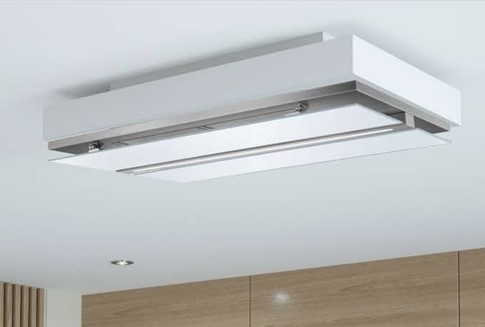
- Ceiling hood is another option for the island kitchen and it also comes in different designs, shapes, and forms
- Common size – 110cm
- Basic designs have three speeds with touch controls and do include a remote control
- Installation of this kind of hood will depend on the location and the island kitchen’s overall design.
- I’m not sure how this type of kitchen hood would perform since the ceiling is designed to be up there…. higher
- For a cooker hood to be effective, it has to be installed according to the implied distance between the cooktop and the hood which is about 65cm (or check your installation manual)
6. Downdraft Hood
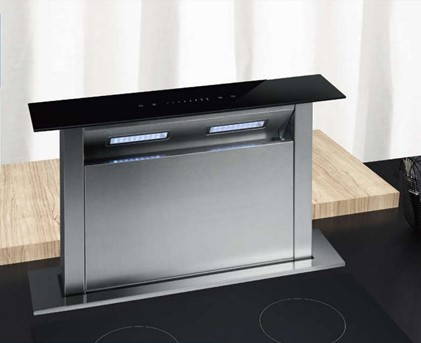
- Down-draft hood is not yet fully utilized, I guess because of the price as it is an expensive option
- Available in 60cm and 90cm sizes
- Function: 4-speed slide touch operation
- Automatic slide elevation
- Installation of this kind of hood will depend on the overall kitchen design
- Manufacturers are developing it as a system paired with premium cooktops such as Induction hob
7. Auto Linkage Hood
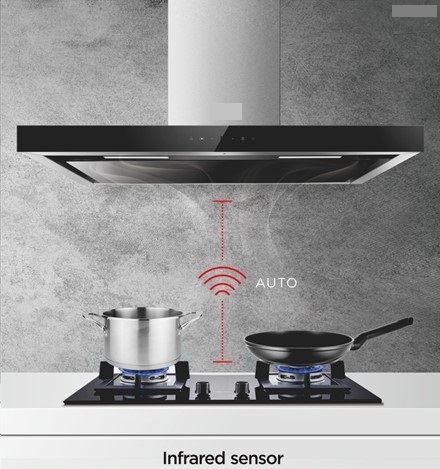
- As I have discussed in my previous article about What is a Smart Appliance, the auto linkage cooker hood will only be possible if paired with the cooktop that works on the same platform.
- It will be useless to only develop a cooker hood with such function and not pair it with the cooktop from the same manufacturer who produces both firmware for the two to interlock and work as designed.
- In my previous job, one of our clients has developed a cooker hood with an auto-linkage function in mind, to make it an option for their targeted end-users. But later on, we have to abandon the idea because the manufacturer told us that the function would be useless if it will not be paired with their designed cooktop.
8. Built-in Hood
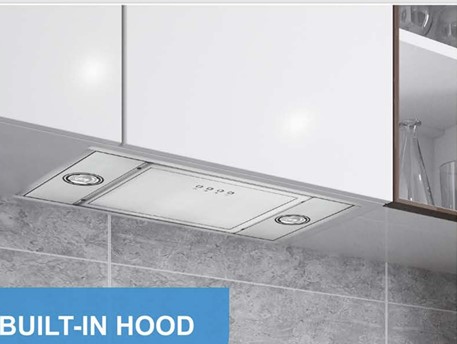
- Built-in hood is almost similar to the standard hood and the telescopic hood that is usually installed under a cabinet… the only difference is that the built-in hood has always to be integrated into a cabinet while the standard and telescopic hoods can be installed independently without a cabinet
- Available in 60cm and 90cm sizes
- Basic design has 3-speed and can have a push-button or touch control
- Depending on the manufacturers, these hoods can be accessorized with flexible exhaust pipe (duct)
How does a cooker hood work?
As I have explained above, the basic function of a kitchen hood is to extract fumes out of the kitchen.
It can be vented outside using the flexible exhaust pipe (duct) or if the kitchen hood employs the recirculation design (ductless) so the air is again released inside the kitchen through the hood’s vents (ductless hoods normally comes with a carbon filter to clean the air it recycles).
For the kitchen hood to work effectively, it must be installed properly in the first place.
Make sure to follow the installation guide and set up your cooker hood according to the suggested distance of the hood from the cooktop.
Install by taking into account hood’s effective distance
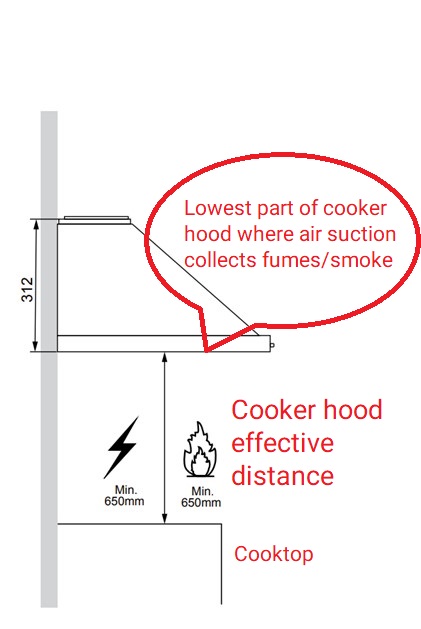
To ensure that the kitchen hood collects the fumes effectively, you must install it according to the suggested distance between the cooktop and the lowest part (entrance) of the hood where the suction of fumes is gathered.
The widely used and accepted distance is about 65cm (see above illustration), however, always check the installation manual to avoid mistake.
Ensure cooker hood is properly installed
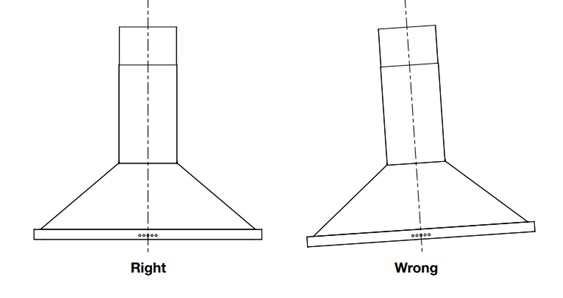
Whether it is a wall-mount type, an island hood, or even just a standard hood, make sure that it is properly positioned to be effective.
As shown in the above figure, the kitchen hood must be fixed straight.
Let’s examine (actual) installed kitchen hood and do range hood really work?

Slant type kitchen hood
So, this is my actual kitchen where a 90cm wall-mount slanted glass type cooker hood was installed. This is more or less a 10 year old kitchen and most appliances are still working.
The cooker hood’s specs are as follows:
Max power: 270W
Motor power: 268W
Airflow: 870±10%m3/h
LED lamp: 2W
Input voltage/freq: 220V~, 50Hz
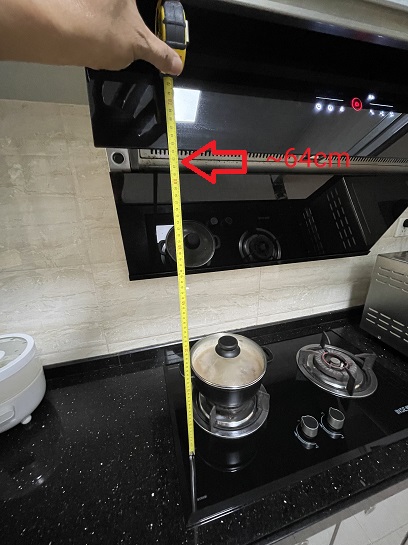
Effective distance (actual)
Measured the distane between cooktop and the lowest part of the hood where smoke enters.
Based on the actual measurement the actual distance of my cooktop from the hood opening is about 64cm.

Chimney
For wall-mount type kitchen hoods it always comes with chimney.
And for this case, they only supplied the lower part (but there are models that will also include an upper decorative chimney, the upper chimney will be useful if chimney are exposed).

Flexible exhaust pipe
To ensure that smoke does not come back, the exhaust pipe has to be securely fitted into the outlet vent.

Control panel
So, for this model it has a touch control with the following functions:
Power key: Press to turn power ON (opens the hood’s air passage) and press again to turn OFF (closes the hood).
Blower speed: 3 speeds (low, mid, high). To activate, need to press the selected speed then press again to turn off.
Auto timer: When pressed for the first time it will run for 3 minutes and will shut-off automatically.
Count down key: When pressed once the unit will run for 15 minutes, if pressed again the unit will run for 30 minutes, press key the third time to cancel function.
LED key: Press to turn LED light ON and OFF
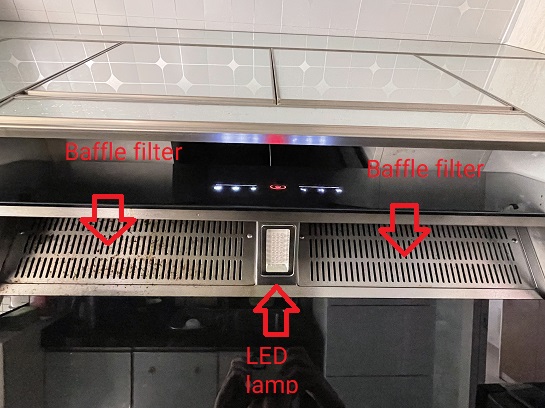
Baffle filters and LED lamp
Other main part of a cooker hood:
LED lamp: Lights up when LED key is pressed.
Baffle filter: Filters the oil so it won’t go straight to the motor.
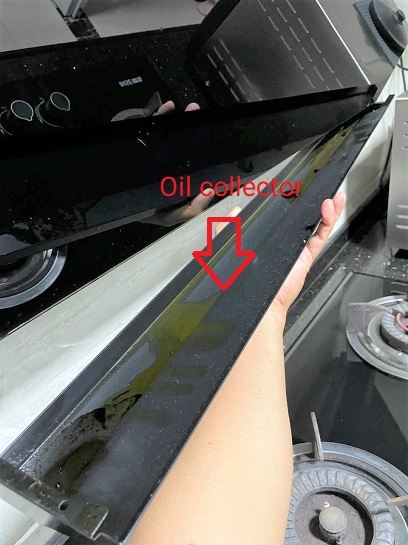
Oil collector
The oil collector is responsible for the gathering of the trapped oil.
From the sample image you can see the presence of oil, thus, proving this range hood works as intended.
Common installation accessories
Supplied accessories will always depend on the model and agreement between the manufacturer and the client.
But this is just to give you an example of what are the standard accessories for kitchen hoods.
Below are common accessories for wall-mount type hoods.
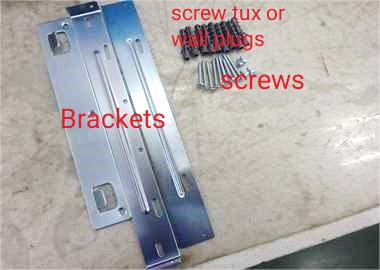
Common installation accessories for wall-mount type hoods are brackets, screws and screw tux or wall plugs.
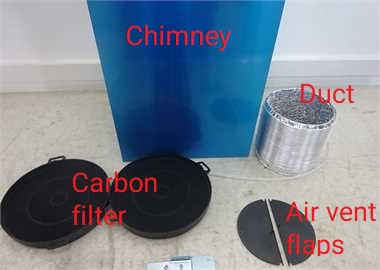
Other common accessories for wall-mount type hood are chimney, flexible exhaust pipe (duct), vent flaps, while the carbon filter mostly are optional.
Note: The function differs according to the design for each brand and model. While the price is dictated by what features, and materials (e.g. stainless steel, glass, motor power and airflow, etc) a kitchen hood has. More so, what accessories come along with it.
Are cooker hoods necessary?
The answer is YES… simply because it helps keep the kitchen tidy and can aid on eliminating odors generated during cooking.
A kitchen that doesn’t utilize range hoods can easily get grimy because of the fumes that are kept circulating inside.
If you cook daily and especially use oil, then it will not take long for your wall and ceiling to become greasy and it will be very evident over time.
Therefore, consider installing a kitchen hood for the above reason!
Final Thoughts
In conclusion, it is essential to have a cooker hood installed in your kitchen for one obvious reason – to keep your kitchen tidy and odor free.
Only install a kitchen hood that is appropriate or matches the design of your kitchen. A ducted cooker hood would be best as it can extract the fumes out of the kitchen. However, as I have mentioned choose what matches your overall kitchen design.
I have provided you with the types of hoods above… if you have a small kitchen, a wall-mounted hood or the standard, as well as the telescopic hood, would fit best.
And in order for the range hood to be effective, you must fix it according to the installation guide and take into consideration the effective distance.
Moreover, it should be mounted properly and straight… not tilting or inclined on one side.
So, there you have it folks, again, thank you for reading. If you find this article helpful or if you have questions and suggestions, please leave them in the comment area. And I will be glad to answer them as soon as I can.
